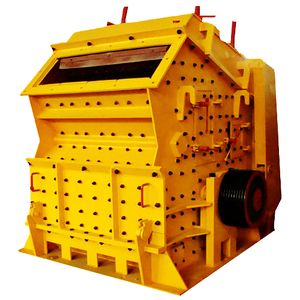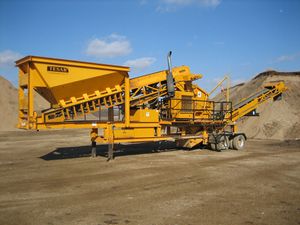Difference between revisions of "Impact Crushers"
(Created page with "Category:Particle Size Reduction{{Knoppen}} <noinclude><!------------------------------------------------ * READ THIS FIRST * Only edit this page if you can improve the ...") |
|||
| Line 7: | Line 7: | ||
* Please start editing this page after the /noinclude | * Please start editing this page after the /noinclude | ||
* -------------------------------------------------></noinclude> | * -------------------------------------------------></noinclude> | ||
[[File:Impact_Crusher1.jpg | thumb | right | Stationary Impact Crusher]] | |||
[[File:Impact_Crusher.jpg | thumb | right | Mobile Impact Crusher]] | |||
The '''impact crusher''' uses plate hammer on the rapidly rotating rotor to generate high-speed impact to crush the materials in the crushing cavity, and casts the crushed materials along tangential direction to impact plate at the other end of the crushing cavity. The materials are crushed again, and then, they return to the plate hammer to undergo the process above repeatedly. | |||
In these [[crushers]], comminution is by impact rather than by compression. Sharp blows are applied at high speed to free-falling rock. The moving parts are beaters, which transfer some of their kinetic energy to the ore particles on contacting them. The internal stresses created in the particles are often large enough to cause them to shatter. These forces are increased by causing the particles to impact upon an anvil or breaker plate. | |||
==Features== | |||
*High reduction ratio and crushing efficiency | |||
*No-board connection | |||
*Crushed product with cubical shape. | |||
*Easy maintenance and reliable operation. | |||
==Movie== | |||
<youtube>0RGLlny65Tg</youtube> | |||
Revision as of 07:38, 31 January 2012
The impact crusher uses plate hammer on the rapidly rotating rotor to generate high-speed impact to crush the materials in the crushing cavity, and casts the crushed materials along tangential direction to impact plate at the other end of the crushing cavity. The materials are crushed again, and then, they return to the plate hammer to undergo the process above repeatedly.
In these crushers, comminution is by impact rather than by compression. Sharp blows are applied at high speed to free-falling rock. The moving parts are beaters, which transfer some of their kinetic energy to the ore particles on contacting them. The internal stresses created in the particles are often large enough to cause them to shatter. These forces are increased by causing the particles to impact upon an anvil or breaker plate.
Features
- High reduction ratio and crushing efficiency
- No-board connection
- Crushed product with cubical shape.
- Easy maintenance and reliable operation.
Movie

